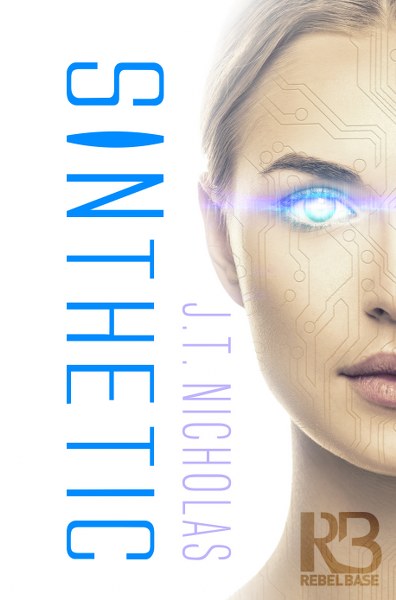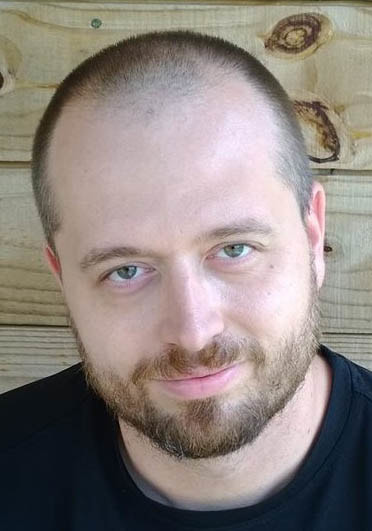SINthetic
The New Lyons Sequence #1
by J.T. Nicholas
Genre: Science Fiction – Cyberpunk Noir
Pub Date: 1/23/2018
The Artificial Evolution
They look like us. Act like us. But
they are not human. Created to perform the menial tasks real humans
detest, Synths were designed with only a basic intelligence and
minimal emotional response. It stands to reason that they have no
rights. Like any technology, they are designed for human convenience.
Disposable.
they are not human. Created to perform the menial tasks real humans
detest, Synths were designed with only a basic intelligence and
minimal emotional response. It stands to reason that they have no
rights. Like any technology, they are designed for human convenience.
Disposable.
In the city of New Lyons, Detective
Jason Campbell is investigating a vicious crime: a female body found
mutilated and left in the streets. Once the victim is identified as a
Synth, the crime is designated no more than the destruction of
property, and Campbell is pulled from the case.
Jason Campbell is investigating a vicious crime: a female body found
mutilated and left in the streets. Once the victim is identified as a
Synth, the crime is designated no more than the destruction of
property, and Campbell is pulled from the case.
But when a mysterious stranger
approaches Campbell and asks him to continue his investigation in
secret, Campbell is dragged into a dark world of unimaginable
corruption. One that leaves him questioning the true nature of
humanity.
approaches Campbell and asks him to continue his investigation in
secret, Campbell is dragged into a dark world of unimaginable
corruption. One that leaves him questioning the true nature of
humanity.
And what he discovers is only the beginning . . .
J.T. Nicholas was born in
Lexington, Virginia, though within six months he moved (or was moved,
rather) to Stuttgart, Germany. Thus began the long journey of the
military brat, hopping from state to state and country to country
until, at present, he has accumulated nearly thirty relocations. This
experience taught him that, regardless of where one found oneself,
people were largely the same. When not writing, Nick spends his time
practicing a variety of martial arts, playing games (video, tabletop,
and otherwise), and reading everything he can get his hands on. Nick
currently resides in Louisville, Kentucky, with his wife, a pair of
indifferent cats, a neurotic Papillion, and an Australian Shepherd
who (rightly) believes he is in charge of the day-to-day affairs.
Lexington, Virginia, though within six months he moved (or was moved,
rather) to Stuttgart, Germany. Thus began the long journey of the
military brat, hopping from state to state and country to country
until, at present, he has accumulated nearly thirty relocations. This
experience taught him that, regardless of where one found oneself,
people were largely the same. When not writing, Nick spends his time
practicing a variety of martial arts, playing games (video, tabletop,
and otherwise), and reading everything he can get his hands on. Nick
currently resides in Louisville, Kentucky, with his wife, a pair of
indifferent cats, a neurotic Papillion, and an Australian Shepherd
who (rightly) believes he is in charge of the day-to-day affairs.
Follow the tour HERE
for exclusive excerpts, guest posts and a giveaway!
for exclusive excerpts, guest posts and a giveaway!

The neon signs glowed sullenly, sending sickly tendrils of light slithering down the rain-soaked streets like so many diseased serpents. Once bright and inviting, the reds and blues and greens had dimmed and paled, sloughed off the flush of health, and left behind a spreading stain of false illumination that heralded nothing but sickness and decay. The signs themselves, flickering and buzzing, wheezing like something that wanted to die, something that should have died long ago, offered up a thousand different sins, unflinching in the frank descriptions of the acts taking place within the walls that they adorned.
I stared at those signs, indistinct and hazy beneath the mantle of falling rain. The mist softened their lurid offers, restoring, however imperfectly, an innocence the city lost long ago. As the gentle caress of a silken veil added mystery to the sweeping curves of the female form, hinting at secrets far more tantalizing than the revealed flesh beneath, the cloak of rainfall shrouded the city’s darker side, softening its edges and lending it an air that approached civility.
Approached civility, but did not—could not—achieve it.
With a sigh, I turned my eyes away from the cityscape, and dropped them to the pavement beneath my feet. To the body that rested there, or what was left of it.
After nearly ten years on the job, I still had to fight down the bile threatening to crawl its way up my esophagus and force its insistent path between my teeth. The body—so much easier to think of it as “the body” and not “the woman”—lay flat on its back, arms stretched out above its head and crossed at the wrists, legs spread akimbo. No clothing. Nor could I see any discarded garments in the immediate area. The pose, purposeful and meticulous in its own horrifying way, was a parody of passion. It was a pose that was likely even now being played out in many, perhaps most, of the establishments adorned with the gasping neon signs.
After nearly ten years on the job, I still had to fight down the bile threatening to crawl its way up my esophagus and force its insistent path between my teeth. The body—so much easier to think of it as “the body” and not “the woman”—lay flat on its back, arms stretched out above its head and crossed at the wrists, legs spread akimbo. No clothing. Nor could I see any discarded garments in the immediate area. The pose, purposeful and meticulous in its own horrifying way, was a parody of passion. It was a pose that was likely even now being played out in many, perhaps most, of the establishments adorned with the gasping neon signs.
With one very notable difference.
Vestiges of beauty clung to the woman, holding desperately to a youthful vivacity that was losing an inexorable battle to the unnatural slackness of death. Makeup adorned that face, hiding the pallor beneath blush and eyeliner, lipstick and shadow, only now beginning to fade and run beneath the unrelenting assault of a thousand raindrops. Her features were symmetrical, regular, past the awkwardness of youth, but not yet touched by the wrinkles or worry lines that would fell all of us in time.
I forced myself to look past her face, past the strong lines of her outstretched arms, sweeping past her bared breasts and to the…emptiness…that extended beneath her sternum.
From her lowest ribs to the tops of her thighs, the woman had been…
I realized I didn’t have a word for what had been done to her. The words that stormed through my mind—savaged, brutalized, tortured—leaving a teeth-gnashing anger in their wake and making my stomach twist itself into a Stygian knot, were almost certainly true, but they did not describe what lay before me.
I realized I didn’t have a word for what had been done to her. The words that stormed through my mind—savaged, brutalized, tortured—leaving a teeth-gnashing anger in their wake and making my stomach twist itself into a Stygian knot, were almost certainly true, but they did not describe what lay before me.
Hollowed.
The word floated up from somewhere in my subconscious, bringing with it memories of carving into pumpkins and scooping out the seeds and ropey innards with big plastic spoons made slick and awkward from the pulpy mess.
I clamped my teeth so hard that a lance of pain shot along my sinus cavities, but it kept me—if only just—from vomiting.
I clamped my teeth so hard that a lance of pain shot along my sinus cavities, but it kept me—if only just—from vomiting.
Hollowed.
The skin and muscle had been removed from the woman’s stomach and groin. The organs that should have been present—stomach, intestines, kidneys, everything south of the lungs—were gone. The tissue beneath them, the muscles along the spine, back, and buttocks remained, exposed to the air and rain. I could just make out pinkish gray tissue poking from beneath the ribs, so I guessed the lungs, and probably the heart, were intact and in place.
There was no blood.
The steady rain had formed a small pool in the resulting cavity, taking on a cast more black than red in the dimness of the night. No more blood on the body. No more blood at the scene.
“Holy Mary, Mother of God.”
The heartfelt exhalation came from behind me, and I glanced over my shoulder, tearing my eyes from the horror before me. The uniforms had finished cordoning off the area, spreading the yellow tape in a rough perimeter maybe twenty yards in diameter. Even on a night like this, in a neighborhood like this, a crowd had gathered, a few dozen people pressed up against the tape as if it were the glass wall at an aquarium, desperate to peer into the darkness and see the wonders and horrors within. All of them pointed screens in my direction or stared with the strange motionless intensity of someone wearing a recording lens. I prayed that the darkness, rain, and distance would cloud their electronic eyes, and grant the woman what little privacy and modesty were left to her.
Halfway between me and the tape stood a small, trim man in his late forties. A fuzz of iron-gray hair sprouted from his head like a fungus, and a pencil-thin beard traced the line of his jaw. He wore blue coveralls, stenciled with the words “Medical Examiner” in gold thread. Dr. Clarence Fitzpatrick had been medical examiner in New Lyons for longer than I’d been a cop. We had worked some gruesome homicides, scenes far messier, at least in terms of scattered gore, than what lay before us. But nothing quite so damn eerie.
“Yeah,” I muttered. “What can you tell me?”
He made his way to the body and knelt by it, blue-gloved hands extended over it as if trying to divine information from the ether. “Liver temp is out of the question,” he said. There was no humor in his voice, no attempt to make light of the nature of the remains; he was simply stating the facts of the case before him, retreating behind cold professionalism. It was something you learned quick on the job. Those who could not put a wall between the atrocities and their own souls never lasted long.
He touched the flesh of the woman’s arm, pressing against it, feeling the elasticity. “No rigor mortis, which means that death was either very recent or she’s been gone awhile.”
He panned a flashlight across the body, the pale flesh luminescing under the harsh white light. “No discoloration of the remaining tissue. The damage sustained to the torso is sufficient to cause death, but there is no way to tell in situ if that occurred before or after she expired. Though if it had been done here, we would certainly be seeing a lot more blood, even with the rain.” He spoke in short, clipped bursts, keeping the medical jargon to a minimum, for my benefit no doubt.
His hands moved to the woman’s head, peeling back the eyelids. “Cloudy. Most likely, she was killed more than twelve, but less than forty-eight hours ago. Apart from the obvious evisceration, there is no readily identifiable cause of death.” He cupped the woman’s face in his hands, twisting it gently to the side, continuing his field examination. He brushed back the dark locks of her hair, revealing the back of her neck. A deep sigh, a sound of relief, not regret, escaped him. “Thank God,” he said.
I stared down at the woman, not really seeing what the doctor saw, but I knew what would be there. Only one thing could have drawn that reaction from Fitzpatrick. A raised pattern of flesh, roughly the size of an old postage stamp, darker than the surrounding skin and looking for all the world like an antiquated bar code. The tissue would be reminiscent of ritualistic scarring, but, unlike the woman herself, would not have known the touch of violence. It could be called a birthmark, but “birth” was not a word applied to the lab-grown people that were, collectively, known as synthetics. They bore other names, of course, dozens of them, all derogatory, all aimed at dehumanizing them further, at driving home the point that, though they might look and act and feel like us, they were not humans.
Dr. Fitzpatrick was not immune to that dehumanization. “Thank God,” he said again. “She’s a mule.”










Sounds like a very good book! (*fingers crossed!)
It was!!